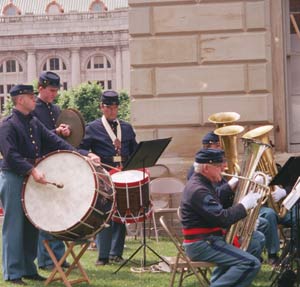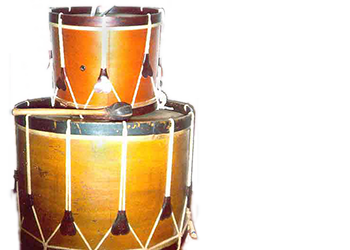by R.C. Murphy
When most people think of the Civil War, they
think of famous generals or battles fought or how politics entered
into an Army operation. But when I think of the War Between the States,
I think of quite possibly the most important member of either side--that
is the drummer.
When the Federal Government needed troops to answer
the call, be it North or South, those troops never left home without
a drummer as an integral part of the unit. Usually they were boys
too young to do the actual fighting but who knew the importance of
a good drummer. What a thrill it must have been for a small boy, who
had probably never been further than a few miles from his town, to
march off to war with a company or regiment of home folk. I think
it would be hard for any of us in this day and age to imagine a boy
joining a fighting unit and going off to war. But almost every city,
town, hamlet or village that sent troops to war, had one or more of
these brave young native sons.
Much is written about the weapons and strategies
of war but little is said about the importance of the drummer. Its
often thought that a drummers' only task was to beat cadence for his
unit while marching. That was only a small part of a day in the life
of a young drummer. Without a drummer to establish communications
and keep order among the units in the field, many campaigns would
have ended in failure. The drummer had many responsibilities, including
using one of many drum calls for everything from assembling officers
for strategy meetings to sounding retreat in the midst of severe enemy
fire. A drummer could always be seen near a high ranking officer because
at any time he might be needed to alert the troops of an upcoming
movement or operations.
Without a drummer to establish communications
and keep order among the units in the field, many campaigns would
have ended in failure. The drummer had many responsibilities, including
using one of many drum calls for everything from assembling officers
for strategy meetings to sounding retreat in the midst of severe enemy
fire. A drummer could always be seen near a high ranking officer because
at any time he might be needed to alert the troops of an upcoming
movement or operations.
Because of his job as the communicator for the
unit, he often did not get enough sleep. At any time he might be needed
to play the appropriate drum call. This meant being awakened at any
hour and not being able to return to sleep for many hours. Once the
men were assembled and deployed to a particular engagement, the drummers
would lay down their drums and take up stretchers, act as runners
between outposts, or do whatever was necessary to help the unit. Many
tales of heroism have been told about these young lads, and many lived
to ripe old ages to tell generations of their contributions to the
war effort.
The Snare drum pictured above was made by The Increase Blake
Co., Farmington Falls, Maine circa. 1861. The inside shell is signed
by Ralph E. Reed 1861 with original drumsticks. Private collection.
Bass drum: Mfg. by The H. R. Eisenbrant Co., Baltimore
Maryland with original beater circa. 1850. Private collection.

